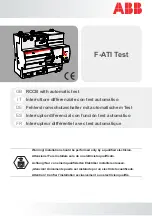
__________________________________________________________________________________
3
thru 9. The TPA fuses are numbered 1 thru 4
for bus A and bus B.
3.3. Fuse Alarm circuitry provides 1 set of form
“C” contacts (C, NO and NC) for each bus (Bus A,
and Bus B). In the event of a fuse alarm or loss of
input power, the proper relay will change states,
providing a connection between the Normally
Op
en “NO” and Common “C”
terminals for that
bus
. The normally closed “NC” terminal will
open to high impedance.
4.
INSTALLATION
Please read completely before beginning.
WARNING:
Installation should only be performed
by an experienced Installer familiar with DC power
distribution systems.
This product must be installed within a
RESTRICTED ACCESS LOCATION where
access is through the use of a tool, lock and
key or other means of security, and is
controlled by the authority responsible for
the location. This product must be installed
and maintained by TRAINED SERVICE
PERSONNEL ONLY.
4.1.
Unpack and inspect the Fuse Panel for
possible damage incurred during shipping. If
damage is found, file a claim immediately with the
carrier, and notify Customer Service.
4.2.
Once the panel is unpacked, verify that there
are three mounting brackets. The bracket with the
vertical
slot is used for both 1” and 1-1/4” hole spacing
applications. There will be two brackets with
horizontal slots, one
will fit 1”, and the other 1-1/4”,
hole
spacing. All three brackets are universal for 19”
and 23” rack mount spacing (see figure 4.2.1) and
can be mounted so the panel can be installed for a
flush mounting or 5” offset. Adjust the position and
orientation of the correct mounting brackets on the
fuse panel, such that it will fit the rack you wish to
mount the panel in. Please see drawing 1123-19 on
page 6 for mounting bracket configurations.
4.3.
Mount the panel on the equipment rack
using the thread forming #12-24 rack mounting
screws and tooth lock washers provided.
Rack Mount Instructions:
Elevated Operating Ambient
- For closed or
multi-unit rack assemblies, the operating ambient
may be greater than room ambient. Take care to
install
the
equipment
in
an
environment
compatible
with
the
maximum
ambient
temperature (Tma) specified by the manufacturer.
Reduced air flow
- Installation of the equipment
in a rack should be such that the amount of air
flow
required
for
safe
operation
is
not
compromised.
Mechanical Loading
- Mounting of the equipment
in the rack should be such that a hazardous
condition is not achieved due to uneven
mechanical loading.
Circuit Overloading
- Consideration should be
given to the connection of the equipment to the
supply circuit and the effect that overloading of the
circuits might have on overcurrent protection and
supply wiring. Appropriate consideration of
equipment nameplate ratings should be used
when addressing this concern.
Reliable earthing
- Reliable earthing of rack-
mounted equipment should be maintained.
Particular attention should be given to supply
connections other than direct connections to the
branch circuit.
19 " MOUNTING
23" MOUNTING
Figure 4.2.1
WARNING:
For safety reasons all wiring should
be done with all power sources removed (when
possible).
Note:
A readily accessible disconnect device shall
be incorporated in the building installation wiring.






















